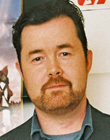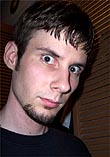|
|
 
|
|
Author
|
Topic: Upper image cropping: What's the cause?
|
|
|
|
|
|
|
|
|
|
|
Monte L Fullmer
Film God

Posts: 8367
From: Nampa, Idaho, USA
Registered: Nov 2004
|
 posted 01-24-2005 03:22 AM
posted 01-24-2005 03:22 AM




...if this was an older LCE complex, they probably had 1050's with Tu-2000's, which have the motorized turrets, motorized aperture change, double set maskings and going through Strong's infamouss CP-10 computerized automation.
I play with three theatres with this setup, only thing is that we've converted the Tu-2000's to manual by taking out all of that motorized jazz.
After awhile, those turrets love to get out of alignment with the flat/scope turret vertical stops getting all astrewed, the lateral settings eventually gets knocked out with all of the rotation. Plus, the turret close stops, which are those mylar bolt heads, can be getting pushed back in to get out of alignment out as well.
Then finally,the turret bearings, which are those very small bearings located in the three-120 degree positions, takes a beating as well and will fail causing the turret disk to start to tilt forward.
Then, we can get to wonder on the actual motor actions as well with those couplers getting tired, which drives the spur/worm gear setup for opening and closing. The aperture jogging motor getting tired, or the aperture getting a bit warped due to excessive heating, being a one piece aperture plate with both openings.
For on cue command by the CP-10, the turret opens, lens rotate, masking shifts and aperture shifts to the preference, turret closes, all within 20 plus feet of black leader spliced inbetween the flat trailers and scope feature.
When the system works, it's quite the interesting thing to watch.
-Monte
| IP: Logged
|
|
|
|
|
|
Jarryd Beard
Expert Film Handler

Posts: 229
From: Hellertown, PA
Registered: Jul 2004
|
 posted 01-24-2005 04:14 PM
posted 01-24-2005 04:14 PM




quote: Rick Raskin
I suspect the lens changed over to scope but the plate failed to do so. Is that feasable? I am suprised they let the film run through that way. BTW, didn't anyone complain?
That was my first thought too, especially since the masking changed from flat to scope before the show started. However, a flat aperture plate crops the bottom as well; this wasn't the case. At first I thought the plates may have travelled vertically instead of horizontally in the projector. I thought maybe it got jammed in its movement. Thanks to some posts and studying of manuals online, I realize that the long plate has two holes and travels horizontally.
Now it makes sense to me that the masking didn't function properly. The horizontal move was made. but the vertical didn't function. I'd assume these are controlled by different motors if that's true, right? Also, remember how I said the full cues were visible in the corner. The image must not have been cut off if these were completely visible. Perhaps the cinematography did cut off a few heads at times. The fact that something was wrong with the picture may have led me to pay more attention to certain shots than I usually would.
I would have complained, but I waited until the move started in hopes it would go away. I thought maybe the feature was flat and just the pre-show was scope. Once the movie started, I couldn't take myself away from it. (I had to piss for about 1 1 /2 hrs of the movie as well.) Anyway, a manager came it and sat down for about 20 minutes of the movie. If he didn't notice it (he probably runs the booth at some point) I wasn't going to try to convince someone so naive that there was a problem.
Full list of presentation issues noted during this show: masking malfunction (sounds oddly familiar), no digital sound, poor focus, very unstable image, slight ghosting, extreme bulb flicker.
[ 01-24-2005, 08:31 PM: Message edited by: Jarryd Beard ]
| IP: Logged
|
|
Monte L Fullmer
Film God

Posts: 8367
From: Nampa, Idaho, USA
Registered: Nov 2004
|
 posted 01-25-2005 02:00 AM
posted 01-25-2005 02:00 AM




quote:
no digital sound, poor focus, very unstable image, slight ghosting, extreme bulb flicker, et.al.
...sounds a-typical for a LOWES/LCE, and almost any of the large circuit's Manager/"Bozo" run operations.
Kinda like all of the Bozos have a standard of operational procecures which curtails all of the above mentioned.
Gee, wonder who came up with this brainy standards of operations anywho?
Wonder if one head BOZO, who is the King of BOZOLAND wrote this manual for all of the other Bozos and any prospective Bozos to follow and to obey. (lol)
Glad, we all are not responsible and for any of the input of this BOZO manual.
Definitely shows who's smart and who's the Bozo.
(okey, I'm getting mean here...lol)
Could be that one of the masking motors popped the reset switch back behind the screen, motor froze up, masking drawstrings all tangled up behind..anything can be possible with double maskings being two motors doing all of this.
-Monte
| IP: Logged
|
|
Brian Guckian
Jedi Master Film Handler

Posts: 594
From: Dublin, Ireland
Registered: Apr 2003
|
 posted 01-25-2005 07:45 AM
posted 01-25-2005 07:45 AM




quote: Jarryd Beard
While I'm leaning towards a complete cropping of the upper 1/8 of the image, the fact that complete changeover/motor cues images were present makes me think otherwise. Wouldn't the cues be closer to the top of the film? Image cropping seems to suggest the flat aperture accidently being left in the projector, but wouldn't that crop the bottom of the picture as well?
The placement of cue marks is nowadays the same for all ratios, i.e. the cue is punched in the same position with reference to the right-hand edge of the film (viewed Heads Up, track on the left), and the top frameline. Therefore, a Scope film projected with a Scope lens but with a Flat plate could still display complete cues.
Also, it is not necessarily the case that a Flat plate will equally crop the top and bottom of a Scope image. Sometimes, the apertures can be lined up with a common top or bottom edge, so that on Scope, the top or bottom portion of the screen can be blank (I've seen it!). In that case, the image also has to be racked in the gate. However, all this would lead to much more than 1/8 of the image being lost from the top of the screen, so I'm fairly sure that's not the problem here.
There were no photography issues that I remember on "Phantom of the Opera". Perhaps the Scope setup is cropped in that theatre, requiring re-framing of the images between Flat and Scope. If there's a skeleton or inexperienced staff it's possible the racking move wasn't done when it should have been, coupled with top masking failure as others have mentioned.
Also, I wouldn't necessarily agree that lack of digital sound is a presentation issue! Dolby SR can sound fantastic in a properly set up and equipped theatre.
| IP: Logged
|
|
|
|
|
|
|
|
All times are Central (GMT -6:00)
|
|
Powered by Infopop Corporation
UBB.classicTM
6.3.1.2
The Film-Tech Forums are designed for various members related to the cinema industry to express their opinions, viewpoints and testimonials on various products, services and events based upon speculation, personal knowledge and factual information through use, therefore all views represented here allow no liability upon the publishers of this web site and the owners of said views assume no liability for any ill will resulting from these postings. The posts made here are for educational as well as entertainment purposes and as such anyone viewing this portion of the website must accept these views as statements of the author of that opinion
and agrees to release the authors from any and all liability.
|

 Home
Home
 Products
Products
 Store
Store
 Forum
Forum
 Warehouse
Warehouse
 Contact Us
Contact Us




 Printer-friendly view of this topic
Printer-friendly view of this topic





![[bs]](graemlins/bs.gif) )
)








![[Smile]](smile.gif)



